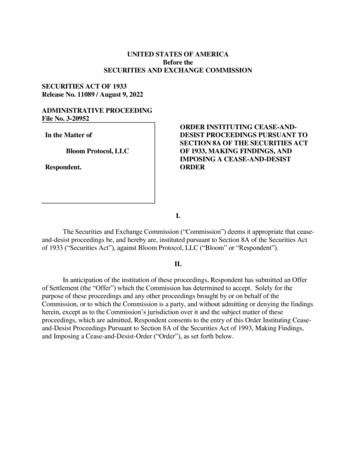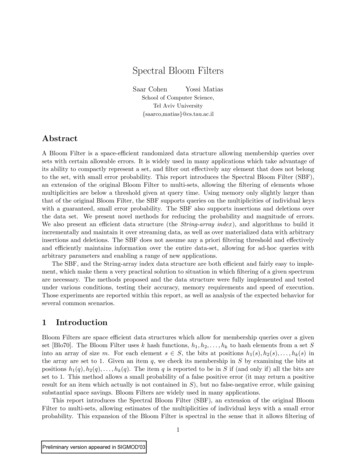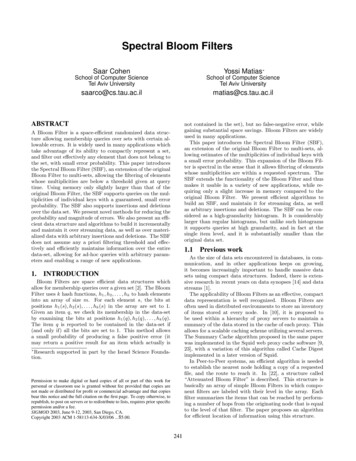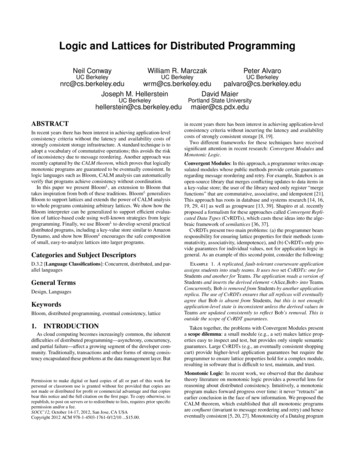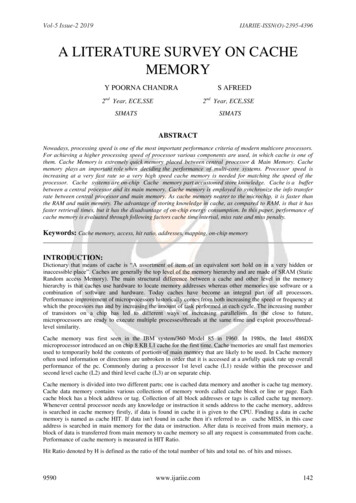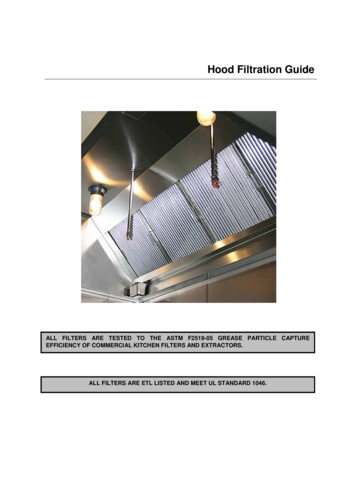
Transcription
Cache Efficient Bloom Filters for Shared MemoryMachinesTim Kalertfk@mit.eduMIT Computer Science and Artificial Intelligence Laboratory32 Vassar StreetCambridge, MA 02139AbstractBloom filters are a well known data-structure that supports approximate set membership queries that report no false negatives. Eachelement in the universe represented by the bloom filter is associatedwith k random bits in the structure. Traditional bloom filters, therefore, require k non-local memory operations to insert an element orperform a lookups. For very large bloom filters, these k lookups mayrequire k disk seeks. Lookups can be expensive even for moderatelysized filters which fit into main memory since k non-local memory accesses may result in L3, L2, and L1 cache misses.In this paper, we implement a cache-efficient blocked bloom filterthat performs insertions and lookups while only accessing a small blockof memory. We improve upon the implementation described by [4] byadapting dynamically to unbalanced assignment of elements to memoryblocks. The end result is a bloom filter whose superior cache localityallows it to outperform a standard bloom filter on a shared memorymachine even when it fits into main memory.This paper also surveys the design and analysis of three existingtypes of bloom filters: a standard bloom filter, a blocked bloom filter,and a scalable bloom filter. Ideas from these data structures will allowfor the implementation of a cache efficient bloom filter which providesgood memory locality. These data structures are used directly by ourcache efficient bloom filter to obtain its properties.1IntroductionBloom filters are an efficient data structure for performing approximate setmembership queries. A traditional bloom filter maintains an array of m bits
to represent a set of size n. It utilizes k hash functions to map each element insome universe to k random bits in its array. An element is inserted by settingits k associated bits to true. A query for approximate set membershipis performed for an element by taking the bitwise AND of its k bits. Ifthe element was inserted into the bloom filter, a lookup for that element isguaranteed to be correct. Sometimes, however, an element which is not inthe set will be mapped to k bits which have been set due to the insertion ofother elements. In this case, a false positive is reported for that element.One problem with traditional bloom filters is that they require k randomIO operations to perform insertions and approximate membership queries. Ifa bloom filter is stored on disk, it may be necessary to perform k disk seeksto access k random bits in the filter’s array. These random IO operationscan also be expensive when the bloom filter fits into main memory.A modern shared memory machine has a heirarchy of caches. Typicallythere are three caches of increasing size: L1, L2, and L3. On the modernmulticore machine used for the experiments in this paper the L1-cache is 32KB, the L2-cache is 128 KB, and the L3-cache is 12 MB. Each level of thecache hierarchy is increasingly expensive to access. Even moderately sizedbloom filters may exceed 12 MB in space. Accessing k random bits in a bitarray much larger than 12 MB may result in up to k expensive L3-cachemisses.This paper explores methods for modifying the standard bloom filterto improve the memory locality of insertions and approximate membershipqueries. Ideally, each element would be mapped to k bits located on thesame cache line (usually 64 bytes) or on the same memory page (usually4096 bytes). Even coarser memory locality, however, may still help reducethe number of L3-cache misses and improve performance.Blocked bloom filters, developed by Putze, Sanders, and Singler, provide a potential solution to the poor memory locality of standard bloomfilters [4]. A blocked bloom filter is composed of b smaller standard bloomfilters of equal size. Each element is mapped to k bits within a single randomly assigned bloom filter. The problem with this approach, however, isthat the random assignment of inserted elements to blocks will result in someblocks becoming overloaded. Inserting too many elements into a given blockwill increase its false probability rate. To compensate, [4] proposes usingmore space by scaling the size of each block by approximately 15 to 30%.This paper considers the question: can we efficiently resize each of theb bloom filters dynamically according to its load to save space? The notionof bloom filters which can resize dynamically has been explored previously.Scalable bloom filters developed by Baquero, Hutchison, and Preguica2
maintain a predetermined failure probability even when the number of inserted elements is not known in advance [1]. This data structure may be usedto implement a dynamic blocked bloom filter whose composite bloom filters resize dynamically in response to unequal load. This data structure isfairly natural since it is merely a composition of existing work. To the best ofthe author’s knowledge, however, this data structure has not been analyzedin previous work.Four types of bloom filters have been implemented during the courseof this project. The standard bloom filter, the blocked bloom filter, thedynamic (scalable) bloom filter, and the dynamic blocked bloom filter. Thefirst contribution of this paper is a survey of the three bloom filter variantspreviously described in the literature coupled with some empirical analysis oftheir performance when implemented. The second contribution is the designand empirical analysis of the dynamic blocked bloom filter which will takeadvantage of the machinery developed during the course of our survey.The following is a brief outline of the contents of the paper. (Section 2) Design and implementation of the standard bloom filterdata structure which requires only 2 independent hash functions, independent of k. (Section 3) A scalable bloom filter which can resize itself dynamicallyat runtime while maintaining the same false positive rate is describedand analyzed. Empirical results provide a direct comparison of the falsepositive rate and memory usage of scalable bloom filters and standardbloom filters. Such a direct comparison appears to have been absentfrom the original scalable bloom filter paper. (Section 4) A blocked bloom filter which is analyzed and empiricallytested in two cases: the case in which insertions are equally distributedamongst all blocks, and the case in which insertions are assigned toblocks according to a random hash function. (Section 5) A dynamic blocked bloom filter is described and analyzed.The false positive rate, runtime, and memory usage is compared withthe standard bloom filter and the blocked bloom filter. (Section 6) A brief conclusion which includes a few informal remarkson some related ideas I found interesting, but did not have time toexplore in this paper.3
2Standard Bloom FiltersIn this section we review the basic theoretical properties of the standardbloom filter for approximate membership queries. We then briefly describeour implementation of the standard bloom filter specifying how to reducethe cost of computing k hash functions and how to guarantee correctnesswhen elements are inserted into the bloom filter concurrently.Formal description and analysisLet S be a set of elements that is a subset of some universe U . Let XS (n, c, k)be a standard bloom filter utilizing cn bits to perform approximate membership queries on a set of size cn. Each element e U can be mappedto k random bits of XS using k independent hash functions h1 , . . . , hk . Toinsert an element e into XS the bits h1 (e), . . . , hk (e) are all set to true.To perform an approximate membership query for the element e the bitwiseAND of its k bits in XS is computed.The false positive rate for XS , fS , is the probability that XS reportsthat an element e / S is a member of the set. The parameter k can beoptimized to minimize the false positive rate as a function of c. After inserting n elements, the probability that a given bit is empty is (1 1/cn)nk .This can be rewritten as ((1 1/cn)cn )k/c e k/c . The probability of reporting a false positive for an element e / S is equal to the probability ofthe k random bits assigned to e being set in XS . This probability is theproduct fS (1 e k/c )k . The approximation for fS is minimized whenk c ln 2 0.7c.We note that for this optimal value of k the probability that any givenbit will be true is (1 e k/c ) 1/2 once all elements have been inserted.Therefore, for the optimal values of k and c the false positive rate for XSwill be fS 1/2k .Hash functionsThe primary implementation concern with the standard bloom filter is thechoice of hash functions. If the k bit indicies for a given element h1 (e), . . . , hk (e)are expensive to compute then they may dominate the cost of insertions andlookups. The hash functions must have certain properties, however, or elsethe false positive rate may increase unacceptably. For example, if the k hashfunctions are only pairwise independent then it has been shown that the falsepositive rate can increase by a constant factor [3].It turns out, however, that it is possible to use 2 independent hash functions to simulate h1 , . . . , hk while maintaining the same asymptotic false pos4
itive rate as when the k hash functions are independent. This result is presented by Adam Kirch, and Michael Mitzenmachert in the paper “Less Hashing, Same Performance: Building a Better Bloom Filter” [3]. Their schemeutilizes two hash functions H1 , H2 , and uses the formula hi H1 iH2 .Using this technique reduces the problem of computing k random bitindices to that of computing 2 independent hash functions. Our implementation computes the two necessary hash functions H1 , H2 using the MurmurHash [2] function which provides good performance in practice. We seedeach of the two hash functions by utilizing the C library’s standard randomnumber generator seeded with the current time.Concurrent accessThis paper will not focus on the concurrent performance of bloom filter variants. It is worth noting, however, that concurrent insertions may introducethe possibility of false negatives in bloom filters. The complexity in implementing a standard bloom filter allowing concurrent inserts arises becausemost architectures do not support atomic writes to a single bit. Commonly,hardware only guarantees that reads and writes to whole bytes will appearatomic. As elements are being inserted into the bloom filter, multiple elements may attempt to set a bit in the same byte. Suppose two processorsattempt to set two different bits to 1 in the same byte b. Each processorwill read the byte b into memory, set the appropriate bit, and then store itsmodified copy of b. If both processors read the byte b before either modifiesit, then the first write will be overridden by the second.In practice, this causes the standard bloom filter to have a non-zerofalse negative probability! For example XS (n 227 , c 20, k 14) reports a number of false negatives commonly ranging from 0 to 20 whenrun on 12 cores. This false negative rate is very small, but it compromisesone of the guarantees provided by standard bloom filters. In our implementation, we resolve this race by utilizing the atomic builtin instructionsync fetch and or. It turns out that the use of this atomic instructiondoes not have a big impact on performance. On simple benchmark withon XS with 50% of all lookups outside the set S, the nonatomic multicoreversion runs in 21.5 seconds, and the atomic multicore versions in 21.8seconds.3Scalable Bloom FiltersA scalable bloom filter [1] is a bloom filter that can resize itself dynamicallywhile maintaining an upper bound on its false positive rate. We first present5
the design and analysis of a scalable bloom filter and then provide empiricalresults using our implementation to demonstrate its false positive rate andspace usage.Design and AnalysisA scalable bloom filter (or dynamic bloom filter) XD is implemented as achain of standard bloom filters XS,1 , . . . XS,t whose false positive probabilities decrease geometrically according to a tightening ratio r. If the falsepositive probability of XS,1 is p, then the false positive probability of the ithfilter in the chain is ri 1 p.Elements inserted into XD are added to the last filter in the chain, XS,t .When XS,t is unable to insert additional elements without sacrificing its falsepositive probability a new standard bloom filter XS,t 1 is added to the chain.The capacity for newly added bloom filters can be chosen independently ofits false positive probability. It is common, however, for the sizes of eachfilter in the chain to grow exponentially to allow the scalable filter to growarbitrarily large while guaranteeing a logarithmic chain length.To perform an approximate membership query on XD a query is performed on each filter in the chain XS,1 , . . . XS,t . The query reports that theelement is in the set if any filter in the chain reports that it contains theelement and returns false otherwise. The probability of a false positive,therefore, is bounded from above by the probability that any filter in thechain reports a false positive.P r(False positive in XD ) tXri 1 pi 1 1p1 rTightening false positive rateIn order to tighten the false positive rate, we recall that a standard bloomfilter XS (n, c, k) has a minimal false positive rate when c k/ ln 2 that isequal to (1 e k/c )k (1/2)k . If the standard bloom filter has a false positiverate of p (1/2)k , then a new standard bloom filter XS (n′ , c′ , k ′ ) with afalse positive rate of p′ rp can be obtained by setting k ′ k lg(1/r),and c′ k ln 2. Then p′ (1/2)k lg(1/r) rp. For our implementations wechoose r 1/2 so that k ′ k 1, and c′ c ln 2. We utilize floating pointrepresentations of k and c to reduce the impact of rounding errors.6
Figure 1: Plot of the memoryuse (in MB) for scalable and standard bloom filters as a functionof the number of hash functionsutilized. Results for the scalablebloom filter are shown for two initial set sizes: 512 elements and2048 elements.Figure 2: Plot of the false positive rate for scalable and standard bloom filters as a function ofthe number of hash functions utilized. The x-axis is on a log (base2) scale. Results for the scalablebloom filter are shown for two initial set sizes: 512 elements and2048 elements.Initializing a scalable bloom filterSuppose that we wish to initialize a scalable bloom filter that maintains thesame false positive probability of a standard bloom filter that knows its sizein advance: XS (n, c, k). Suppose that the false positive probability of XSis q. The bound on the scalable bloom filter’s false positive rate shows thatto guarantee a false positive rate of q the false positive probability of thefirst bloom filter in the chain must be p (1 r)q. As we saw when wetightened the false probability rate of each filter in the chain, this requiresus to increase k by lg(1/(1 r)) and the number of bits per element bylg(1/(1 r))/0.7. For example, if r 1/2 this, then we increase k by 2 andthe number of bits per element by 2/0.7 2.85. The first bloom filter inthe chain, therefore, will be XS,1 (n′ , c 2.85, k 2) where n′ is an initialestimate of the size of the set.7
Implementation, and empirical resultsI ran an experiment to compare the false positive rate and memory usageof the standard and scalable bloom filters. A total of n 225 randomelements (pseudorandom integers) were inserted into each bloom filter. Then2n lookups were performed n of which were guaranteed to have been insertedinto the set. An exact set data structure containing all inserted elements wasused to compute the exact number of false positives. The standard bloomfilter was initialized assuming a set of size n, but the scalable bloom filtersused smaller intial set sizes of 512 and 2048. The tightening ratio for thescalable bloom filters was chosen to be r 1/2 and the capacity of XS,i 1was set to be double the capacity of XS,i , bounding the length of the chainby lg n.The result of the experiment measuring memory usage is displayed inFigure 1. Note that the initial size of the bloom filter can have a big impacton memory usage. The scalable bloom filter intially sized to contain 512elements uses roughly double the space of the scalable bloom filter initiallysized to contain 2048 elements. The reason for this increased space usage isthat each bloom filter in the chain requires additional bits for each insertedelement to guarantee a tightened false positive rate.An additional phenomenon we note is that the initial size of the scalablebloom filter appears to have an impact on its false positive rates in practice.A comparison of the scalable bloom filters initialized with 512 and 2048elements with the standard bloom filter in Figure 2 reveals that the filterwith initial capacity of 2048 elements matches the false positive rate of thestandard bloom fitler for larger values of k. The false positive rate of the filterwith initial capacity 512 grows larger than that of the standard bloom filterwhen more than 12 hash functions are used. The filter with initial capacity2048, however, has a false positive rate that is lower than the standard bloomfilter until 15 hash functions are used. It is, of course, expected that theinital capacity would have some effect on the false positive rate because thefalse positive rate of a scalable bloom filter experiencing t resize operationswill be the sum of t terms in a geometric series converging to its desiredprobability. The magnitude of the effect, however, is somewhat surprising.The original work on scalable bloom filters in [1] did not provide a directempirical comparison of the false positive rates of scalable and standardbloom filters. For this reason, it is unclear whether this phenomenon is dueto a subtle implementation bug (perhaps a rounding error) or has some othercause (perhaps related to the imprecision of various approximations).8
4Blocked Bloom FiltersIn this section we describe the blocked bloom filter as described in [4] andanalyze its real world performance when its blocks are evenly and unevenlyloaded.Design and analysisSuppose we have a blocked bloom filter XB (n, c, k, b) where b is the numberof blocks. Let n be the total number of elements inserted into XB . As withthe standard bloom filter, we will store c bits for each element n. Each blockis a standard bloom filter of capacity n/b containing cn/b bits. To performinsertions and lookups a hash function s : U {1, . . . , b} is used to assignelements from the universe U to one of b bloom filter blocks. The insertion orlookup for that element is then performed on its assigned bloom filter. Ourimplementation utilizes the MurmurHash function (with a distinct seed) toperform this sharding.We now will estimate the false probability rate of this blocked bloomfilter. After all elements have been inserted the false positive probability ofeach bloom filter block will be fixed. Let fBi be the false positive rate ofthe ith bloom filter block. Consider an element e which was not insertedinto XB . To lookup e we map e to one of b bloom filter blocks, Bi . Wethen perform a regular bloom filter lookup for e in block Bi . The falsepositive probability for the ith bloom filter is fBi . Therefore, we have thatP r(false positive on e e Bi ) fBi . Using the chain rule of probability wecan compute the probability of a false positive when looking up e in XB .P r(false positive on e) bXfBi 1ibPerfectly balanced caseThe false positive rate of a blocked bloom filter depends on the distribution ofinserted elements among its b blocks. In general, the more unevenly elementsare distributed among its blocks the larger the false positive probability.The best case performance of the blocked bloom filter, therefore, can beascertained by testing its performance on an insertion set which shards evenlyinto its b blocks.In this ideal case, we can analyze the theoretical false positive rate ofthe blocked bloom filter. Each block is a standard bloom filter with cn/bbits. By assumption, each block has received n/b insertions. Therefore, the9
Bloom Filter1. Standard BF2. Blocked BF Balanced3. Blocked BF UnbalancedCache References45.257 M/sec30.250 M/sec32.695 M/secRuntime172.53s154.97s163.81sFalse Positive Rate0.014%0.013%0.021%Figure 3: Comparison of the cache performance and runtime of the several variants of thestandard bloom filter and the blocked bloom filter under different sharding distributions.The cache misses statistic was gathered using the perf stat command. These experimentswere run using parameters n 227 elements, c 20, k 13. n insertions were performedfollowed by 2n lookups (half of which were contained in the set).false positive probability for any block i is fBi (1 e k/c )k . Since weknow the false positive rate of each of the b bloom filters we can computethe probability of reporting a false positive for an element for an elemente / S.P r(false positive on e) bXfBi 1ib (1 e k/c )kIndeed, we observe that in practice blocked bloom filters have false positive probabilities that are asymptotically the same as the standard bloomfilter with the same parameters c, k when their blocks are balanced.Empirical evaluationI performed an experiment to measure the relative cache efficiency of thestandard bloom filter and the blocked bloom filter under balanced and unbalanced distributions of insertions to blocks. The blocked bloom filters storea fixed number of elements in each block. Each block contains 2944 elementsusing approximately 6835 bytes of space. The runtime, total number of cachereferences, and false positive rates are reported in Figure 3.The total number of cache references for the blocked bloom filter is approximately 30% lower than for the standard bloom filter under both balanced and unbalanced insertion distributions. This translates into a roughly10% improvement in overall runtime. The false positive rate for the unbalanced blocked bloom filter, however, is larger than the false positive rate forthe standard bloom filter by a factor of 1.5. The blocked bloom filter withbalanced insertions, however, has a false positive rate that is actually slightlylower than that of the standard bloom filter.10
Unbalanced caseThe unbalanced assignment of inserted elements to bloom filter blocks has animpact on the false positive rate for blocked bloom filters as seen in Figure 3.If each inserted elements is assigned a random block then we expect thesizes of the blocks to follow a binomial distribution. Experimentally, wheninserting 225 elemenst into 655360 bins the average is 51 element, but theminimum is 20 and the maximum is 90.The remainder of this paper will discuss how “scalable bloom filters” canbe used to allow each bloom filter block in XB to grow dynamically when itis overloaded.5Dynamic Blocked Bloom FilterThe blocked bloom filter previously described was composed of b standardbloom filters whose sizes were determined statically based on their expectedsizes. The dynamic blocked bloom filter is a blocked bloom filter in whichthe size of each block is grows dynamically as the number of elements insertedincreases. This allows the dynamic blocked bloom filter to maintain a lowfailure probability without needing to scale the size of every block by a fixedpercentage. In practice, the failure probabilities provided by the dynamicblocked bloom filter match those of the standard bloom filter fairly closelyfor values of k between 5 and 15.Design and analysisThe dynamic blocked bloom filter is composed of b blocks. Each block is ascalable bloom filter with initial capacity n/b. The tightening ratio used forthe scalable bloom filters was chosen to be r 1/2 for simplicity. Basedon the analysis in Section 3 we match the false positive rate of a standardbloom filter with parameters c, k by configuring each scalable bloom filter toinitially use k ′ k 2 hash functions and c′ c 2/0.7 bits per elements.As seen in Figure 4 this additional space requirement has an impact on thespace efficiency of dynamic blocked bloom filters for small values of k. Fork 8, however, the total space used (including dynamic resizing) is less than20% of the space used by a standard bloom filter.When a scalable bloom filter reaches its capacity it resizes itself by addingan additional bloom filter to its chain with a tighter false probability rate. InSection 3 we increased the size of each filter in the chain exponentially so thatthe length of the chain would be logarithmic in the number of inserted elements. Exponential growth is not required to guarantee a logarithmic chain11
Figure 4: Plot of the relative space usage of the dynamic blocked bloom filterin comparison to the standard bloom filter as a function of the number of hashfunctions used. A point (x, y) on the plot is implies that for k x, the dynamicblocked bloom filter uses y times as much space as the standard bloom filter.length for scalable bloom filter blocks, however, because with high probability no scalable bloom filter block will grow to be larger than Θ(n log(n)/b).To reduce space usage, scalable bloom filter blocks grow by a fixed amountdefined to be a fraction of their initial capacity.Performance resultsI ran experiments to compare the runtime and false positive rate of thedynamic blocked bloom filter against the blocked and standard bloom filters.Figure 5 contains two plots of the relative speedup achieved over thestandard bloom filter by the blocked and dynamic blocked bloom filters.When the bloom filter size is smaller than 8 MB the blocked bloom filtersare slower than the standard bloom filter. The relative performance betweenthe standard and blocked bloom filters is nearly constant when the bloomfilter size is less than 8 MB. However, as the bloom filter size grows to beapproximately 16-32 MB the performance gap between the standard andblocked bloom filters closes rapidly. After the bloom filter exceeds 32MB insize the blocked bloom filters perform better than the standard bloom filter.Why does the relative performance change so rapidly as the set size entersthe 16-32MB range? A likely explanation is that it is within this range thatthe standard bloom filter begins to incur expensive L3 cache misses that themore cache efficient blocked filters avoid. The L3 cache on the experimental12
Figure 5: Two plots showing thespeedup achieved by the staticand dynamic blocked bloom filter when compared to the standard bloom filter. The x-axis ofthe first plot shows the numberof elements inserted. The x-axisof the second plot shows the total space in MB used by the filter. The benchmark was run using k 15 hash functions. Thesebenchmarks were run on a single core of a multicore machine.The machine used was an IntelXeon X5650 with 49GB DRAM,two 12-MB L3-caches each sharedbetween 6 cores, and private L2and L1-caches with 128 KB and32 KB, respectively. Since thebenchmark was run on a singlecore the program had access to4 GB of DRAM, a single 12-MBL3-cache, a 128 KB L2-cache,and a 32 KB L1-cache.machine is approximately 12 MB which is quite close to the point at whichthe relative performance between the standard and blocked filters begins tochange.Figure 6 demonstrates that the dynamic blocked bloom filter has a lowerfalse positive rate than the static blocked bloom filter and can match thefalse positive rate of the standard bloom filter for values of k between 5 and15.6ConclusionThis paper has surveyed and implemented three known bloom filter variants:the standard bloom filter, the scalable bloom filter, and the blocked bloomfilter. In addition, we presented a fourth bloom filter called the dynamicblocked bloom filter which utilizes ideas from blocked and scalable bloomfilters to obtain a cache efficient bloom filter which maintains tighter failureprobabilities. Improving cache locality appears to be worthwhile for bloom13
Figure 6: Plot of the false positive rate of the dynamic blocked bloom filter, theblocked bloom filter and the standard bloom filter as a function of the number ofhash functions used. The x-axis is on a log (base 2) scale. The false positive ratewas calculated by inserting 224 random elements into each set and then performing225 lookups. Half of the lookups were guaranteed to be positive. False positiveswere detected using an exact set data structure containing all inserted elements.filters even when they fit into main memory. Performance improvements wereobserved for cache efficient bloom filter variants when filters were larger thanthe experimental machine’s L3 cache. The source code for this project is onbitbucket (https://bitbucket.org/tfk/bloom-project).Future explorationThe following are extensions and ideas, described informally, which did notmake their way into this paper. It may be interesting the explore these ideasmore fully in future work.Overflow table An alternative approach to dynamically resizing the bloomfilter blocks is to use an additional bloom filter to contain all elements whichhave “overflowed.” If an inserted element cannot be added to a bloom filterblock without causing that block to exceed its capacity, then it is insertedinto the overflow bloom filter. This method can be applied recursively sothat the overflow bloom filter could be, itself, a cache efficient bloom filter that handles overflow. Not all lookups would be required to query theoverflow filter: only those which queried a block that was at capacity. Still,since some lookups may need to query the overflow table it is necessary to14
tighten the false probability rate: requiring more bits per inserted element.Fortunately, however, the size of the overflow table need only be a fraction ofthe size of the original table since most inserted elements will not overflow.Exter
Even coarser memory locality, however, may still help reduce the number of L3-cache misses and improve performance. Blocked bloom filters, developed by Putze, Sanders, and Singler, pro-vide a potential solution to the poor memory locality of standard bloom filters [4]. A blocked bloom filter is composed of bsmaller standard bloom filters of equal size. Each element is mapped to k bits .
